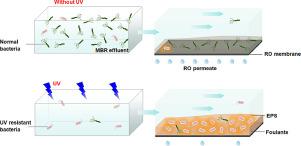Water Research ( IF 11.4 ) Pub Date : 2021-03-02 , DOI: 10.1016/j.watres.2021.116995 Yin-Hu Wu , Zhuo Chen , Xu Li , Yun-Hong Wang , Bo Liu , Gen-Qiang Chen , Li-Wei Luo , Hao-Bin Wang , Xin Tong , Yuan Bai , Yu-Qing Xu , Nozomu Ikuno , Cai-Feng Li , Hong-Yu Zhang , Hong-Ying Hu

|
Membrane fouling is a prominent problem that hinders the stable and efficient operation of the reverse osmosis (RO) system for wastewater reclamation. Previous studies showed that chlorine disinfection, which was commonly used in industrial RO systems as pretreatment, could lead to significant change in microbial community structure and resulted in serious biofouling. In order to prevent biofouling during wastewater reclamation, the effect of ultraviolet (UV) disinfection on RO membrane fouling was investigated and the mechanism was also revealed in this study. With the disinfection pretreatment by UV of 20, 40 and 80 mJ/cm2, the bacteria in the feed water were inactivated significantly with a log reduction of 1.11, 2.55 and 3.61-log, respectively. However, RO membrane fouling aggravated with higher UV dosage. Especially, in the group with the UV dosage of 80 mJ/cm2, the normalized RO membrane flux decreased by 15% compared with the control group after 19-day operation. The morphology of the fouled RO membranes indicated serious biofouling in all groups. The analysis on the microbial amount of the foulants showed that the heterotrophic plate counts (HPC) and ATP content on the fouled RO membranes with and without UV disinfection were at the same level. However, the total organic carbon content of the foulants with the UV dosage of 40 and 80 mJ/cm2 was significantly higher than the control group, with higher content of proteins and polysaccharides as indicated by EEM and FTIR spectrum. Microbial community structure analysis showed that some typical UV-resistant bacteria were selected and remained on the RO membrane after disinfection with high UV dosage, including. These residual bacteria after disinfection with high UV dosage showed higher extracellular polymeric substances (EPS) secretion compared with those without UV disinfection, and thus aggravated RO membrane fouling. Thicker EPS could decrease the transmission of UV rays, and thus bacteria with higher EPS secretion might be selected after UV disinfection.
中文翻译:

紫外线消毒对市政污水再生利用反渗透膜结垢的影响
膜污染是一个严重的问题,阻碍了反渗透(RO)系统用于废水回收的稳定和有效运行。先前的研究表明,通常在工业反渗透系统中用作预处理的氯消毒可能会导致微生物群落结构发生重大变化,并导致严重的生物污染。为了防止废水回收中的生物污染,研究了紫外线(RO)污染对反渗透膜污染的影响,并揭示了其机理。经过20、40和80 mJ / cm 2的紫外线消毒预处理,进水中的细菌被灭活了,对数降低分别为1.11、2.55和3.61-log。然而,较高的紫外线剂量加剧了反渗透膜结垢。特别是在紫外线剂量为80 mJ / cm 2的组中,术后19天,归一化的RO膜通量与对照组相比下降了15%。RO膜结垢的形态表明所有组中均存在严重的生物结垢。对污垢物微生物量的分析表明,在有和没有进行紫外线消毒的情况下,污垢反渗透膜上的异养菌板数(HPC)和ATP含量都处于同一水平。但是,紫外线剂量为40和80 mJ / cm 2时,污垢物的总有机碳含量如EEM和FTIR光谱所示,该蛋白显着高于对照组,其中蛋白质和多糖含量更高。微生物群落结构分析表明,选择了一些典型的抗紫外线细菌,并用高剂量的紫外线消毒后仍保留在反渗透膜上。与未进行紫外线消毒的细菌相比,高剂量紫外线消毒后的这些残留细菌显示出更高的细胞外聚合物质(EPS)分泌,因此加剧了反渗透膜结垢。较厚的EPS可能会降低紫外线的透射率,因此UV消毒后可能会选择具有较高EPS分泌的细菌。











































 京公网安备 11010802027423号
京公网安备 11010802027423号